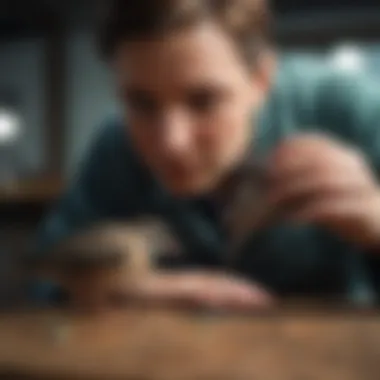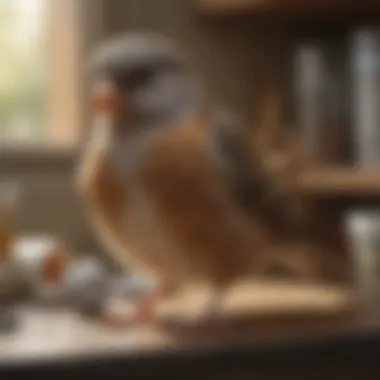Expert Guide: Who to Call if You Encounter an Injured Bird


Overview of the Topic
When you come across an injured bird, it is crucial to understand the necessary steps to ensure its well-being and survival. This informative guide delves into the importance of seeking professional help and handling the situation responsibly to protect our avian friends.
Key Contacts for Injured Birds
Bird Rehabilitators
To effectively assist an injured bird, contact local bird rehabilitators who specialize in caring for avian species. These professionals have the skills and resources to provide proper medical attention and rehabilitation.
Wildlife Rescue Organizations
Wildlife rescue organizations play a vital role in rescuing and rehabilitating injured birds. They have trained personnel who can respond promptly to provide aid to birds in distress.
Veterinarians
In cases of severe injuries, consulting a veterinarian who specializes in avian medicine is essential. Vets can offer medical treatment and advice on how to best help the injured bird.
Handling Injured Birds
Approach with Caution
When approaching an injured bird, do so with caution to avoid causing further harm or distress. Move slowly and calmly to prevent startling the bird.
Use Proper Equipment
If necessary, use gloves or a towel to handle the bird gently. This helps protect both you and the bird from any potential harm during the rescue process.
Provide Temporary Shelter


While waiting for professional help, create a safe and warm environment for the injured bird. Place it in a ventilated box lined with a soft cloth to minimize stress.
Conclusion
Encountering an injured bird can be a distressing experience, but knowing who to call and how to handle the situation can make a significant difference in saving its life. By reaching out to the right professionals and following proper protocols, we contribute to the welfare and conservation of our feathered companions.
Identifying an Injured Bird
In this article, the focus shifts to the crucial task of identifying an injured bird, a key step in ensuring its prompt and appropriate care. Recognizing signs of distress in avian species may significantly impact their chances of recovery and survival. One must pay close attention to specific elements such as visible wounds, abnormal behavior, and difficulty flying, enabling quick intervention to alleviate suffering and enhance the bird's well-being.
Common Signs of Injury
Visible Wounds
Visible wounds are a significant indicator of bird injury, often manifesting as cuts, bruises, or lacerations on the bird's body. They serve as a clear visual cue for assessing the severity of the trauma and determining the necessary course of action. These wounds play a crucial role in identifying the extent of physical harm suffered by the bird, aiding in effective decision-making to provide the appropriate care promptly. While obvious, visible wounds demand attention, the challenge lies in handling them delicately to prevent further harm during the rescue or transport process.
Difficulty Flying
The inability to fly represents a distinct sign of injury or underlying health issues in birds. Difficulty flying may stem from various conditions such as wing fractures, muscle weakness, or systemic illnesses affecting the bird's motor functions. This symptom is vital in the identification process as it indicates the bird's compromised mobility and ability to fend for itself in the wild. Understanding the implications of difficulty flying equips individuals with essential knowledge to approach and assist the bird with care, minimizing stress and ensuring the best possible outcome.
Unusual Behavior
Unusual behavior observed in birds, such as disorientation, lethargy, or aggression, can signal distress or injury. Deviations from normal behavioral patterns provide critical insights into the bird's condition and aid in determining the urgency of intervention required. Recognizing and interpreting these behaviors accurately is fundamental to assessing the bird's well-being and taking appropriate actions to secure professional assistance. However, distinguishing between typical and abnormal behaviors necessitates keen observation and understanding of avian behavior to address the bird's needs effectively.
Approaching the Bird Safely
Approaching an injured bird demands cautious and deliberate steps to ensure both the rescuer's safety and the bird's well-being. Safe handling practices, including maintaining caution and avoiding sudden movements, are essential in minimizing stress and preventing further harm to the injured avian species. By exercising vigilance and employing proper techniques when approaching the bird, individuals can establish a safe environment for assessment and potential rescue operations. These considerations encompass the necessary precautions to facilitate a smooth and successful rescue process, prioritizing the preservation of the bird's health and reducing unnecessary disturbances.
Taking Responsible Action


In this article, Taking Responsible Action is crucial when you find an injured bird. By acting responsibly, you contribute to the bird's well-being and increase its chances of survival. Responsibly addressing the situation involves contacting the right professionals, providing temporary aid, and ensuring that the bird is transported safely to the appropriate facilities.
Contacting the Right Professionals
Local Wildlife Rehabilitation Centers
Local Wildlife Rehabilitation Centers play a vital role in the rescue and rehabilitation of injured birds. These centers specialize in caring for wildlife and have the necessary expertise to handle various injuries. By contacting a Local Wildlife Rehabilitation Center, you ensure that the bird receives proper treatment and care from trained professionals. The proximity of these centers to the bird's location is advantageous as it reduces the transportation time and stress on the bird. However, one downside is that some centers may have limited capacity and resources.
Licensed Wildlife Rehabilitators
Licensed Wildlife Rehabilitators are individuals authorized to treat and care for injured wildlife. They bring specialized knowledge and skills to the field, providing personalized care to each bird. Choosing a Licensed Wildlife Rehabilitator ensures tailored assistance for the bird's specific needs. Their dedication and experience make them a popular choice for injured bird rescue. Despite their expertise, availability may vary depending on the region.
Emergency Hotlines
Emergency Hotlines offer immediate assistance in critical situations involving injured birds. By calling these hotlines, you can quickly connect with professionals who can provide guidance on how to handle the injured bird. The hotline operators can offer advice on first aid measures and the next steps to take. This prompt support can be life-saving for the bird. However, depending on the hotline's capacity, there may be times when reaching a hotline operator proves challenging.
Providing Temporary Aid
Creating a Safe Environment
Creating a Safe Environment for the injured bird is essential to ensure its well-being during the waiting period. By providing a safe and quiet space, you minimize stress and prevent further injuries. This temporary shelter allows the bird to rest and recover before professional help arrives. The safety of the environment directly impacts the bird's chances of survival. However, maintaining a safe environment may require specific resources and careful implementation.
Offering Water and Food Cautiously
Offering Water and Food Cautiously is a delicate task when providing temporary aid to an injured bird. Hydration and nutrition are vital for its recovery, but improper feeding can harm the bird further. By offering water and food with caution, you prevent choking hazards or digestive issues. This careful approach ensures that the bird receives the necessary sustenance without causing harm. However, determining the bird's dietary needs may pose a challenge without proper guidance.
Transporting the Bird
Using a Ventilated Container


Using a Ventilated Container for transporting the injured bird is crucial to its safety and comfort. Proper ventilation prevents overheating and ensures a constant airflow for the bird. The container's design should allow for easy monitoring of the bird's condition during transit. Additionally, ventilation reduces stress on the bird, promoting a calmer journey to the rehabilitation facility. However, finding a suitable container with the right size and ventilation may require prior preparation.
Ensuring Minimal Handling
Ensuring Minimal Handling of the injured bird minimizes additional stress and potential harm. Excessive handling can exacerbate injuries or cause distress to the bird. By limiting physical contact to essential tasks, such as placing the bird in the transport container, you protect its well-being. Minimal handling also reduces the risk of transmitting diseases or further injuring the bird accidentally. However, minimal handling while ensuring secure containment can be a delicate balance that requires caution and precision.
Resources for Further Assistance
In this crucial section, we delve into the significance of additional aid for injured birds. Resources for further assistance play a vital role in ensuring the well-being and survival of these creatures. By having access to specialized support, individuals can take appropriate action promptly and efficiently, ultimately increasing the chances of successful rehabilitation and release back into the wild.
Online Platforms and Apps
Wildlife Rehabilitation Directories
Wildlife rehabilitation directories offer a centralized platform for individuals to locate authorized centers and professionals dedicated to rehabilitating injured birds. These directories showcase a comprehensive list of organizations, along with their contact information and areas of expertise. By utilizing wildlife rehabilitation directories, individuals can quickly connect with skilled experts who possess the necessary knowledge and resources to handle bird injuries effectively.
The key characteristic of wildlife rehabilitation directories lies in their ability to streamline the process of finding help for injured birds. This centralized approach simplifies the search for assistance, ensuring that individuals can promptly reach out to the most suitable rehabilitation facilities or experts in their vicinity. One standout advantage of wildlife rehabilitation directories is the ability to access verified and reliable information, reducing the risk of engaging with unqualified or untrustworthy services.
Locating Nearby Assistance
When it comes to seeking immediate aid for an injured bird, locating nearby assistance is paramount. This aspect focuses on leveraging geolocation services or apps to identify the closest wildlife rehabilitation centers or professionals in the vicinity. By pinpointing nearby assistance, individuals can minimize delays in providing care to the injured bird, enhancing the prospects of a speedy recovery.
The primary benefit of locating nearby assistance is the swift access to help, as time is often of the essence when dealing with injured wildlife. By utilizing this feature, individuals can ensure that the bird receives timely and appropriate care, which is essential for its overall well-being. However, a potential disadvantage of relying solely on nearby assistance is the limited scope of options available, which may require individuals to expand their search radius in cases where specialized care is needed.
Educational Workshops and Seminars
Training on Bird Handling
Training on bird handling serves as a fundamental aspect of preparing individuals to provide immediate care to injured birds. These workshops and seminars offer valuable insights into the proper techniques for assessing and managing bird injuries, equipping participants with the skills necessary to respond effectively in critical situations.
The key characteristic of training on bird handling is its practical approach to imparting essential knowledge and skills to participants. By actively engaging in hands-on training sessions, individuals gain confidence in handling bird injuries, ensuring that they can respond appropriately when encountering an injured bird. One notable advantage of this training is the opportunity to learn from experienced professionals, allowing participants to benefit from expert guidance and best practices in bird care.
First-Aid Techniques
First-aid techniques play a pivotal role in providing immediate relief to injured birds before professional help arrives. Understanding essential first-aid procedures, such as wound cleaning and bandaging, can significantly impact the bird's chances of recovery and survival. By familiarizing themselves with basic first-aid techniques, individuals can offer crucial support to injured birds in distress.
The key characteristic of first-aid techniques lies in their simplicity and effectiveness in addressing common bird injuries. These techniques are designed to be user-friendly, enabling individuals to administer basic care without extensive medical training. An advantage of mastering first-aid techniques is the ability to stabilize the bird's condition while awaiting professional assistance, potentially improving the bird's overall prognosis.



